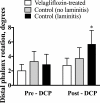The sodium-glucose co-transporter 2 inhibitor velagliflozin reduces hyperinsulinemia and prevents laminitis in insulin-dysregulated ponies
- PMID: 30212530
- PMCID: PMC6136744
- DOI: 10.1371/journal.pone.0203655
The sodium-glucose co-transporter 2 inhibitor velagliflozin reduces hyperinsulinemia and prevents laminitis in insulin-dysregulated ponies
Abstract
There are no registered veterinary drugs for treating insulin dysregulation and preventing insulin-associated laminitis in horses. Velagliflozin is a sodium-glucose co-transport 2 inhibitor that reduces renal glucose reabsorption, promotes glucosuria, and consequently, decreases blood glucose and insulin concentrations. This study aimed to determine if velagliflozin reduced hyperinsulinemia and prevented laminitis in insulin-dysregulated ponies fed a challenge diet high in non-structural carbohydrates (NSC). An oral glucose test (1 g dextrose/kg BW) was used to screen 75 ponies for insulin dysregulation, of which 49 ponies with the highest insulin concentrations were selected. These animals were assigned randomly to either a treated group (n = 12) that received velagliflozin (0.3 mg/kg BW, p.o., s.i.d.) throughout the study, or a control group (n = 37). All ponies were fed a maintenance diet of alfalfa hay for 3 weeks, before transferring to a challenge diet (12 g NSC/kg BW/d) for up to 18 d. Blood glucose and serum insulin concentrations were measured over 4 h after feeding, on d 2 of the diet. The maximum glucose concentration was 22% lower (P = 0.014) in treated animals, with a geometric mean (95% CI) of 9.4 (8.0-11.0) mM, versus 12.1 (10.7-13.7) mM in the controls. This was reflected by lower (45%) maximum insulin concentrations in the treated group (P = 0.017), of 149 (97-228) μIU/mL, versus 272 (207-356) μIU/mL for controls. The diet induced Obel grade 1 or 2 laminitis in 14 of the 37 controls (38%), whereas no velagliflozin-treated pony developed laminitis (P = 0.011). Velagliflozin was well-tolerated, with no hypoglycemia or any clinical signs of adverse effects. The main limitation of this study was the sample size. Velagliflozin shows promise as a safe and effective compound for treating insulin dysregulation and preventing laminitis by reducing the hyperinsulinemic response to dietary NSC.
Conflict of interest statement
The funders of this study have filed international patent applications on the use of SGLT2 inhibitors in horses: Boehringer Ingelheim Vetmedica GmbH, WO2014/161836 and WO2015/150299 entitled “Treatment of metabolic disorders in equine animals”. Boehringer Ingelheim is currently exploring the possibility of the commercial use of velagliflozin in horses. DR is an employee of Boehringer Ingelheim and is named as an inventor on the above patent. This does not alter our adherence to all PLOS ONE policies on sharing data and materials. All other authors have declared that no competing interests exist.
Figures


Similar articles
-
The efficacy and safety of velagliflozin over 16 weeks as a treatment for insulin dysregulation in ponies.BMC Vet Res. 2019 Feb 26;15(1):65. doi: 10.1186/s12917-019-1811-2. BMC Vet Res. 2019. PMID: 30808423 Free PMC article.
-
The oral glucose test predicts laminitis risk in ponies fed a diet high in nonstructural carbohydrates.Domest Anim Endocrinol. 2018 Apr;63:1-9. doi: 10.1016/j.domaniend.2017.10.008. Epub 2017 Nov 16. Domest Anim Endocrinol. 2018. PMID: 29172109
-
Glucagon-like peptide-1, insulin-like growth factor-1, and adiponectin in insulin-dysregulated ponies: effects of feeding a high nonstructural carbohydrate diet and association with prospective laminitis.Domest Anim Endocrinol. 2020 Apr;71:106397. doi: 10.1016/j.domaniend.2019.106397. Epub 2019 Sep 13. Domest Anim Endocrinol. 2020. PMID: 31812879
-
Sodium-glucose transport protein 2 inhibitor use in the management of insulin dysregulation in ponies and horses.J Vet Pharmacol Ther. 2025 Jan;48 Suppl 1(Suppl 1):31-40. doi: 10.1111/jvp.13470. Epub 2024 Jul 10. J Vet Pharmacol Ther. 2025. PMID: 38984777 Free PMC article. Review.
-
Field treatment and management of endocrinopathic laminitis in horses and ponies.Vet Clin North Am Equine Pract. 2010 Aug;26(2):379-90. doi: 10.1016/j.cveq.2010.05.001. Vet Clin North Am Equine Pract. 2010. PMID: 20699182 Review.
Cited by
-
The efficacy and safety of velagliflozin over 16 weeks as a treatment for insulin dysregulation in ponies.BMC Vet Res. 2019 Feb 26;15(1):65. doi: 10.1186/s12917-019-1811-2. BMC Vet Res. 2019. PMID: 30808423 Free PMC article.
-
A "modified Obel" method for the severity scoring of (endocrinopathic) equine laminitis.PeerJ. 2019 Jun 7;7:e7084. doi: 10.7717/peerj.7084. eCollection 2019. PeerJ. 2019. PMID: 31211020 Free PMC article.
-
The application of a new laminitis scoring method to model the rate and pattern of improvement from equine endocrinopathic laminitis in a clinical setting.BMC Vet Res. 2021 Jan 7;17(1):16. doi: 10.1186/s12917-020-02715-7. BMC Vet Res. 2021. PMID: 33413384 Free PMC article.
-
Nutraceutical Supplement Mitigates Insulin Resistance in Horses with a History of Insulin Dysregulation During a Challenge with a High-Starch Diet.Animals (Basel). 2024 Nov 25;14(23):3385. doi: 10.3390/ani14233385. Animals (Basel). 2024. PMID: 39682351 Free PMC article.
-
ECEIM consensus statement on equine metabolic syndrome.J Vet Intern Med. 2019 Mar;33(2):335-349. doi: 10.1111/jvim.15423. Epub 2019 Feb 6. J Vet Intern Med. 2019. PMID: 30724412 Free PMC article.
References
-
- McGowan C, Frost R, Pfeiffer D, Neiger R. Serum insulin concentrations in horses with equine Cushing's syndrome: response to a cortisol inhibitor and prognostic value. Equine Veterinary Journal. 2004;36:295–298. - PubMed
-
- Donaldson M, LaMonte B, Morresey P, Smith G, Beech J. Treatment with pergolide or cyproheptadine of pituitary pars intermedia dysfunction (equine cushing's disease). Journal of Veterinary Internal Medicine. 2002;16:742–746. - PubMed
Publication types
MeSH terms
Substances
LinkOut - more resources
Full Text Sources
Other Literature Sources
Medical

